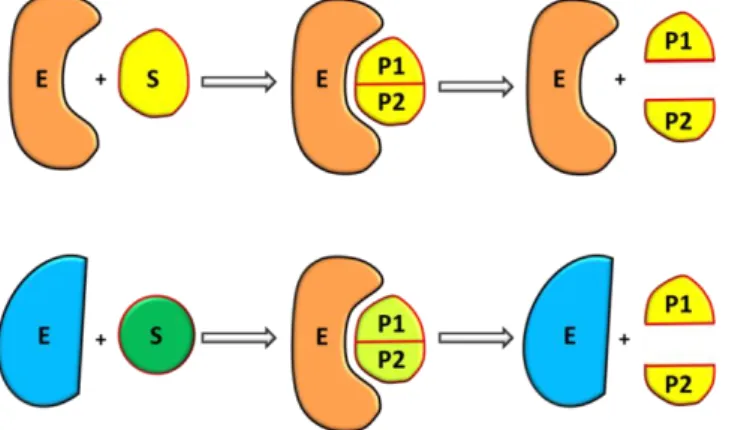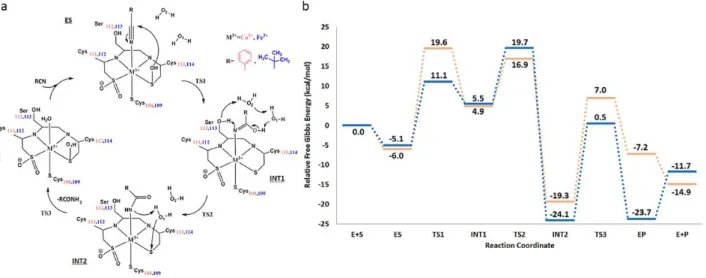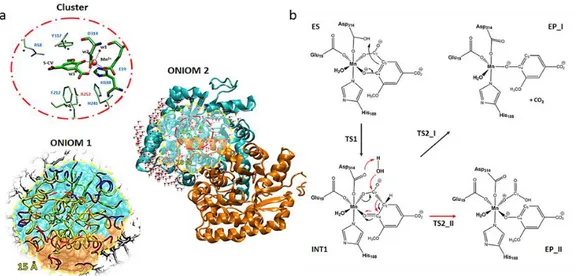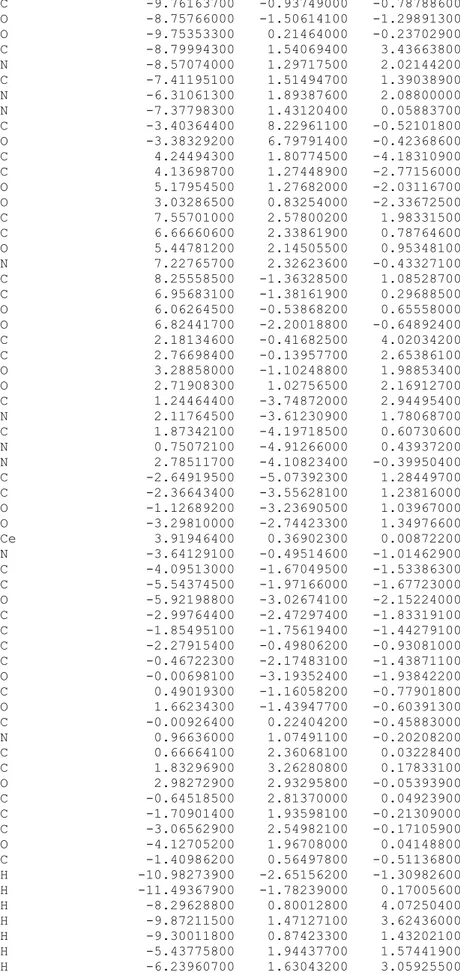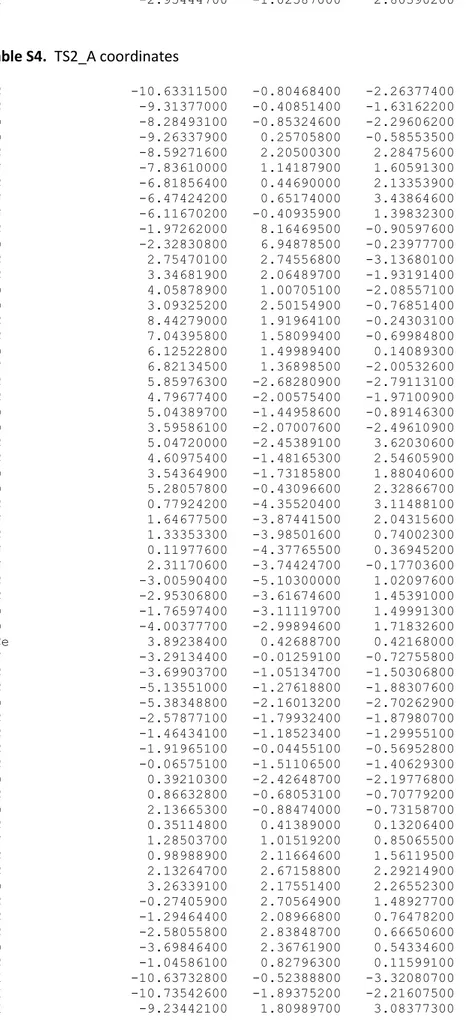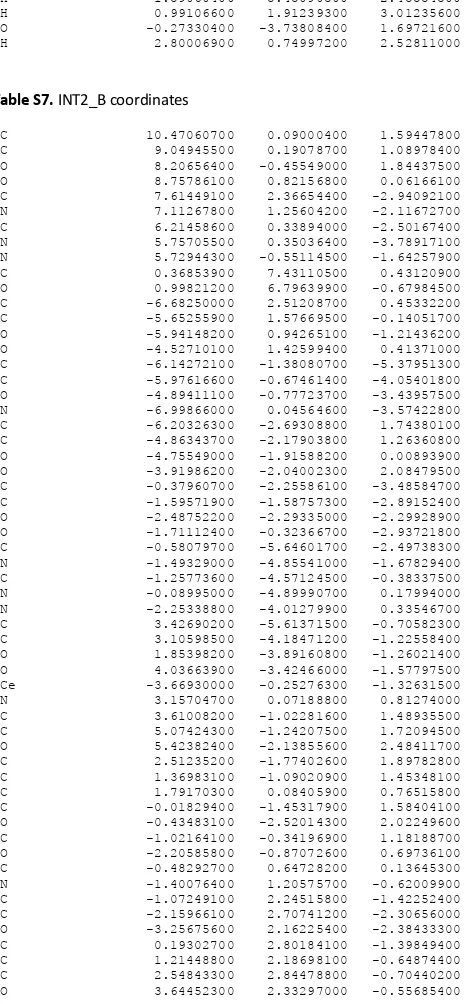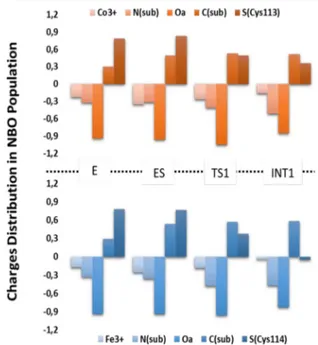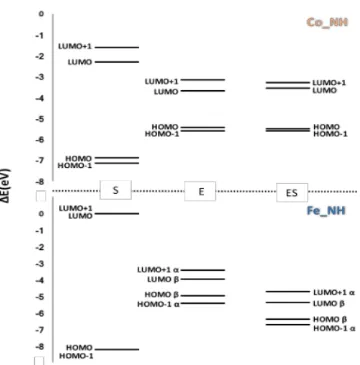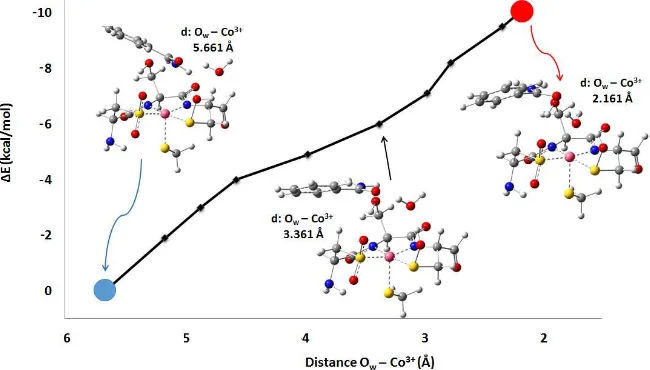Abstract
Computational Enzymology is became a powerful tools to investigate reactions occurring in
enzymatic environment. Nowadays, the modern methodologies coupled to an increasing hardware
power allow to investigate several aspects of the interaction between enzyme and substrate, since
this last one arrives in proximity of the active site until it is been processed, transformed and
released as product. For these reasons, computer simulations are equally relevant to the laboratory
experiments, because they provide accurate and detailed aspects at atomistic level. These
information are subsequently used in many fields, like design of biomimetics species (biocatalysts)
and of new drug (more than 50% of commercial drugs are enzyme inhibitors). The present thesis is
based on studies about enzymes belonging to different enzymatic classes and adopting many tools
provided by modern theoretical and computational chemistry. Coupling quantum mechanics (QM)
based on the Density of Functional Theory (DFT) and hybrid quantum mechanics/molecular
mechanics (QM/MM) methods, with Molecular Dynamics (MD) simulations, the study of the
reaction mechanisms of the selected enzymes has been deeply addressed and the role of the protein
surrounding has been evaluated. In Chapter 1 a brief outline of theoretical background with the
different applied computational approaches is given. In the Chapter 2 are highlighted relevant
aspects of modern enzymology, starting from historical background. The results from the
calculations on the specific enzymes are presented in Chapter 3, in particular:
In the session 1 are reported results by QM/MM and/or QM investigations for four
metalloenzymes: the methanol-de-hydrogenase (MDH, EC 1.1.2.7), the nitrile hydratase
(NHase, EC 4.2.1.84), the peptide glycan N-polysaccharide deacetylase (PDA, EC
3.5.1.104), and 5-carboxyvanillate de-carboxylase (LigW, EC 3.1). In the case of MDH and
NHase enzymes, the catalytic mechanisms, the electronic properties and the role of the
amino acid residues surrounding the active site have been evaluated depending on the nature
of the metal Ca/Ce for MDH (Paper I) and Fe/Co for NHase, (Paper II). For the Zn
dependent PDA enzyme, deeper insights on its catalytic power, due to the presence in active
site of a hydroxyl proline modified after post translational mutation, have been gained in
comparison with that of the natural proline (Paper III) and finally in the case of the LigW, a
Mn dependent enzyme, different models and different approaches have been evaluated with
the aim to get information about how theoretical kinetics parameters variate. (Paper IV)
In the session 2, the human transketolase (hTK, EC 2.2.1.1), an enzyme presenting the
cofactor thiamine diphosphate as co-catalytic agent, has undergone to an accurate study,
adopting different methodologies, in order to quantify the ground state de-stabilization effect
to the catalysis. (Work in progress 1)
In the session 3, QM, QMMM and MD results about glutathione S-transferase Pi 1
(GSTP1, EC 2.5.1.18), as promising enzyme target of the inhibitor piperlongumine (PL), a
new potential anti-cancer drug are given (Paper V)
Finally in the section 4, the catalytic mechanism of a fully de novo protein is presented.
Results obtained for this engineered system show as the adopted computational
methodologies can provide important information for its possible catalytic use. (Work in
2
Enzyme EC Organism Reaction Methods
Paper I Methanol Dehydrogenase 1.1.2.7 Methylacidiphilu m fumariolicum SolV Full QM Paper II Nitrile hydratase 4.2.1.84 Rhodococcus erythropolis Pseudonocardia thermophila Full QM Paper III Peptide glycan N-polisaccaride deacetylase
3.5.1.104 Bacillus cereus Full QM MD
Paper IV 5-carboxyvanillate decarboxylase 3.1 Novosphingobium aromaticivorans Full QM QMMM Paper V Glutathione
S-transferase Pi 1 2.5.1.18 Homo Sapiens
MD Full QM QMMM
Wp 1 Human
tranketolase 2.2.1.1 Homo sapiens
MD Full QM QMMM Wp 2 CC-Hept-Cys18 -His22-Glu25 - - QMMM MD
3
Contents
Acknowledgements ... 5
List of publications ... 6
Amino Acid Abbreviations... 8
List of Abbreviations and Acronyms ... 9
Chapter 1 ... 10
1.1 Introduction... 10
1.2 Theory ... 11
1.2.1 Density Functional Theory ... 11
1.2.2 Molecular Dynamics ... 14
1.2.3 Molecular Docking ... 15
1.3 Methods ... 16
1.3.1 Full QM methodologies: the Cluster Approach ... 16
1.3.2 Hybrid QM/MM and ONIOM methodologies ... 17
References ... 19
Chapter 2 ... 22
2.1 Introduction... 22
2.2 One hundred years of models ... 23
2.2.1 Michaelis Menten Kinetic ... 24
2.3 Cofactors ... 25 2.4 Catalysis ... 26 2.5 Inhibition ... 27 2.6 De Novo proteins ... 28 References ... 29
Chapter 3 ... 32
Section 1 ... 32 3.1 Metalloenzymes ... 323.1.1 Cerium Methanol de-hydrogenase (Paper I) ... 32
3.1.2 Nitrile Hydratase containing Iron and Cobalt (Paper II) ... 34
3.1.3 Peptidoglycan N-acetylglucosamine deacetylase containing Zinc (Paper III) ... 37
3.1.4 5-carboxyvanillate decarboxylase containing Manganese (Paper IV) ... 37
Section 2 ... 40
3.2 human Transketolase (Wp 1) ... 40
Section 3 ... 40
3.3 Inhibition of glutathione S-transferase (Paper V) ... 40
Section 4 ... 40
3.4 De novo protein (Wp 2) ... 40
4
Concluding Remarks ... 43
Paper I ... A
Paper II ... B
Paper III ... C
Paper IV ... D
Paper V ... E
Wp 1 ... F
Wp 2 ... G
5
Acknowledgements
First of all, I express my gratitude to the past and present members of PROMOCS
laboratory at Department of Chemistry and Chemical Technologies of University of
Calabria, which supported me with their friendly and collaborative presence, in the
last three years.
My sincere thanks to my supervisor Prof. Tiziana Marino, for her patience and strong
will to share with me her knowledge, for all those stimulating discussions and
opportunities for personal growth.
I would thank Prof. Nino Russo for his guidance. His encouragement was continued
spur to keep going with scientific curiosity and to hard work.
Thanks to Prof. Maria João Ramos, who gave me the opportunity to spend a research
period at the University of Porto, and to Prof. Pedro Alexandrino Fernandes. In
particular, thank you for all the inspiring discussions. Thanks to Fabiola Medina and
to all the members of Computational Chemistry and Biochemistry Group for their
support during my stage in Porto.
6
List of publications
The results in the present thesis are based on following papers.
I.
How Can Methanol Dehydrogenase from Methylacidiphilum fumariolicum Work
with the Alien Ce
IIIIon in the Active Center? A Theoretical Study
Mario Prejanò, Tiziana Marino, Nino Russo
Chem. Eur. J. 2017, 23, 8652-8657.
doi:10.1002/chem.201700381
II.
Reaction Mechanism of Low-Spin Iron(III)- and Cobalt(III)-Containing Nitrile
Hydratases: A Quantum Mechanics Investigation
Mario Prejanò, Tiziana Marino, Carmen Rizzuto, Josè Carlos Madrid Madrid, Nino Russo,
Marirosa Toscano.
Inorg. Chem. 2017, 56, 13390-13400.
doi: 10.1021/acs.inorgchem.7b02121
III.
Why nature prefers hydroxy-proline in the deacetylation process promoted by
peptide glycan N-deacetylase: insight from molecular simulations
Luigi Sgrizzi, Mario Prejanò, Isabella Romeo, Tiziana Marino, Nino Russo
Manuscript submitted
IV.
QM Cluster or QM/MM in Computational Enzymology: The Test Case of
LigW-Decarboxylase
Mario Prejanò, Tiziana Marino, Nino Russo
Frontiers in chemistry, 2018, 6, 249-257.
doi: 10.3389/fchem.2018.00249
V.
On the inhibition mechanism of glutathione transferase P1 by piperlongumine.
Insight from theory
Mario Prejanò, Tiziana Marino, Nino Russo
Manuscript submitted and accepted
Work in progress (Wp)
Wp 1. How the destabilization of a reaction intermediate affects enzymatic catalysis: the
case of human transketolase
Mario Prejanò, Fabiola E. Medina, Tiziana Marino, Pedro Alexandrino Fernandes, Maria
Joao Ramos, Nino Russo
Manuscript in preparation
Wp 2. Mechanistic insights of hydrolytic activity into a de novo Functional protein
framework.
Mario Prejanò, Isabella Romeo, Tiziana Marino, Nino Russo
Work in progress
The contribution by the author to the papers is summarized as follows:
Paper I
Performed the calculations, analyzed the results and took part in the writing of the
article.
7
Paper II
Performed a part of the calculations, analyzed the results and took part in the writing
of the article.
Paper III
Performed the QM calculations, analyzed the results and took part in the writing of
the article.
Paper IV
Performed the calculations, analyzed the results and took part in the writing of the
article.
Paper V
Performed the calculations, analyzed the results and took part in the writing of the
article.
Wp 1
Performed the calculations, analyzed the results and took part in the writing of the
article.
Wp 2
Performed the QMMM calculations, analyzed the results and took part in the writing
of the article.
8
Amino Acid Abbreviations
Ala Alanine
Arg
Arginine
Asn
Asparagine
Asp
Aspartate
Cys Cysteine
Gln
Glutamine
Glu
Glutamate
Gly
Glycine
His
Histidine
Ile
Isoleucine
Leu
Leucine
Lys
Lysine
Met
Methionine
Phe
Phenylalanine
Pro
Proline
Ser
Serine
Thr
Threonine
Trp
Tryptophan
Tyr
Tyrosine
Val
Valine
9
List of Abbreviations and Acronyms
2-Hyp 2-Hydroxy-Proline M06-L Minnesota 06 Local
5-CV 5-CarboxyVanillate MD Molecular Dynamics
AHS Amidohydrolase MDH Methanol De Hydrogenase
AMBER Assisted Model Building with Energy Refinement MM Molecular Mechanics
ATP Adenosine-Three Phosphate MM2 Molecular Mechanics 2
B3LYP Becke 3 parameter Lee-Yang-Parr mPW Meta Perdew Wang
B88 Becke 88 mPWB1K Meta Perdew Wang Becke 95 1
B95 Becke 95 mPWB95 Meta Perdew Wang Becke 95
B97D Becke 97 Dispersion NAD Nicotinamide adenine dinucleotide
CC-Hept Coiled Coil Heptamer NBO Natural Bond Orbital
CC-Hept Coiled Coil Heptamer NHase Nitrile Hydratase
CHARMM Chemistry at HARvard Molecular Mechanics ONIOM Our own N-layered Integrated MO and MM
CVFF Consistent Valence Force Field OPLS Optimized Potential for Liquid Simulations
DFT Density Functional Theory P Perdew
E Enzyme P86 Perdew 86
E4P Erytrose 4 Phosphate PBE Perdew Burke Ernzerhof
EC Enzyme Commission PBEh Perdew Burke Ernzerhof hybrid
EI Enzyme-Inhibitor PDA Polysaccharide DeAcetylase
EP Enzyme-Product PDB Protein Data Bank
ES Enzyme-Substrate PES Potential Energy Surfaces
ESI Enzyme-Substrate-Inhibitor PL PiperLongumine
F6P Fructose 6 Phosphate pNPA para Nitro Phenol Acetate
FF Force Field PQQ Pyrrol Quinoline Quinone
G3P Glyceraldehyde 3 Phosphate PTM Post Translational Modification
GlcNAc Peptidoglycan N-acetylglucosamine PW91 Perdew Wang 91
GROMOS GROningen MOlecular Simulation QCFF/PI Quantum Consistent Force Field PI electrons
GSH Glutathione QM Quantum Mechanics
GSTP1 Gluatahione S-Transferase Pi 1 QM/MM Quantum Mechanics / Molecular Mechanics
HF Hartree Fock REM Rare Earth Metal
HOMO Highest Occupied Molecular Orbital RNA RiboNucleic Acid
hPL Hydrolyzed PiperLongumine S Substrate
hTK Human TransKetolase ThDP Thiamina Diphosphate
KS Kohn Sham TK TranKetolase
LUMO Lowest Unoccupied Molecular Orbital TS Transition State
LYP Lee Yang Parr TST Transition State Theory
M06 Minnesota 06 UFF Universal Force Field
10
Chapter 1
Theories and methods
Enzymes, being macro-molecules, are too large to be studied in their totality, applying pure
quantum mechanics. According with the type of investigated phenomenon, different theories and
different approaches can be used to study enzymes and reactions catalyzed by them. This chapter
gives a brief overview of the different theory levels and methods used for the calculations presented
in this thesis. In detail, will be reported a summary about density functional theory, molecular
docking, molecular mechanics and molecular dynamics, applied to computational enzymology.
Coupling full Quantum Mechanics (QM) and hybrid Quantum Mechanics/Molecular Mechanics
(QMMM) methods, accurate Potential Energy Surfaces (PESs) to evaluate and predict mechanistic
aspects of catalysis and enzyme-inhibitor reactions at atomistic level can be obtained.
1.1 Introduction
The modelling of reactions in enzymatic environment may be considered as an important piece of
the Computational Enzymology puzzle, which, in the same way, is a piece of the multi-scale
modelling puzzle. This means that, according with the investigated information, and its relative
observation-time, specific levels of theory and models may be applied (see Figure 1). To study
enzymes, the adopted models are different according with the circumstances about the
11
interactions between the enzymes and molecules (substrates and inhibitors) involved in reaction, as
showed in Scheme 1. In the first part, substrate (S) binds reversibly to the enzyme (E) forming the
ES complex. In the second step, chemical reactions converting substrate in product (P) happen.
Passing from interacting enzyme-product step (EP) to the step without interaction (E+ P), the cycle
is restored with the arrival of a new substrate (S). For each step, is possible to build up models with
different dimensions and to extrapolate different information.
Scheme 1. Generic catalytic cycle favored by the presence of an enzyme.
In this thesis, attention is focused on the
𝐸𝑆
→ 𝐸𝑃 step, applying. Since the most important
𝑘2aspect of enzymatic reactions is the increase of reaction rate, using the transition state theory (TST)
it is possible to theoretically determine energy barrier that in turn can be compared with the
experimental one, according to the equation:
RT G B cat
e
h
T
k
k
* *
(Eq. 1.1)
T is the temperature, k
b and h are the Boltzmann and Planck constants, respectively, R is theuniversal gas constant and ΔG** is the activation energy for the reaction. ΔG** corresponds to the
highest barrier calculated, obtained as a difference between transition state energy and its previous
intermediate, once defined the reaction pathway.
1.2 Theory
1.2.1 Density Functional Theory
The quantum mechanics treatment of a chemical system provides the solution of Schrödinger
equation. The equation not dependent by the time, in the non-relativistic form, is:
E
12
For a molecular system with N electrons and M nuclei, the Hamiltonian operator “
Hˆ
” is written, in
atomic units:
N i j i M A B A AB B A ij N i M A N i M A iA A A A ir
Z
Z
r
r
Z
M
H
, 1 1, 1 1 1 1 2 21
2
1
2
1
ˆ
(Eq. 1.3)
The first and the second terms of equation represent the kinetic energy contribution of electrons and
nuclei; the third, fourth and fifth are the potential energy contributions obtained considering
electron-nucleus attractive interactions, electron-electron and nucleus-nucleus repulsive
interactions, respectively. According with the Born-Oppheneimer
1approximation is possible to
consider separately the nuclei and electrons contributions. Despite the rigorous mathematical
formalism, all ab initio methods need approximations to solve Schrödinger equation. Several ab
initio methodologies could be applied, consistently with the system dimension, but the Density
Functional Theory (DFT) is still widely used, from the last 20 years to our days, to study complex
poly-electrons systems, as the catalytic site of enzymes, thanks to the electron density
(r
)
definition, where N is the number of electrons:
r
dr
N
(
)
(Eq. 1.4)
The modern DFT methods base on the two Hohenberg and Kohn (HK) theorems
2and the
Kohn-Sham (KS) formalism.
3The first HK theorem demonstrates that the only fundamental variable that
determines the Hamiltonian, the eigenvalues correlated to its and the ground-state wave function
, is the electron density
(r
)
. The second HK theorem demonstrates that exists a variational
principle such that any trial
' r
(
)
will result in an energy higher than or equal to the exact
ground-state energy. Applying KS formalism is possible to define
(r
)
considering the atomic orbital set
i
:
N i ir
r
1 2)
(
)
(
(Eq. 1.5)
The electronic energy is expressed as the sum of the three different electron terms, as previously
cited:
(
r
)
T
(
r
)
V
(
r
)
V
(
r
)
E
i
ij
iA
(Eq. 1.6)
The
Vij
(r)
term contains the classical Coulomb integral (
J
(r)
) and all non-classical
electron-electron interactions.
Ti
(r)
contains two different kinetic contributions: the first obtained
13
difference between non-interacting and real electron system. Grouping the last cited energy
contribution and the non-classical electron-electron interactions
E
(r)
is defined as:
(
r
)
T
(
r
)
J
(
r
)
V
(
r
)
E
(
r
)
E
ni
iA
xc
(Eq. 1.7)
Unfortunately, does not exist an exact expression of the exchange-correlation functional
Exc
(r)
and various DFT methods have been developed in order to find accurate expression of this
functional. DFT functionals can be divided in two main groups, pure and hybrid functionals,
according with their obtainment and mathematical expression. Considering
E
xc
(r
)
as follow:
(
r
)
E
(
r
)
E
(
r
)
E
xc
x
c
(Eq. 1.8)
several exchange, correlation and exchange-correlation functionals were proposed. Example are:
Correlation functionals: LYP,
4B95,
5PBE,
6P86
7and PW91.
8a
Exchange functionals: B88,
9PBE and PBEh,
10mPW
11and wPBEh.
12
Pure exchange-correlation functionals: M06-L
13and B97D.
14About hybrid functionals, the most famous and used are B3LYP,
4,9,15M06,
16PBEPBE
17and
wB97XD.
18Another class of DFT methods is the meta-hybrid functional, with MPWB1K and
MPWB95,
19particularly recommended for thermochemical kinetics studies.
19As far as the study of
enzyme reaction mechanisms by applying the cluster approach, the hybrid functional B3LYP has
been extensively applied as it has been considered to be a good trade-off between accuracy and
speed. More detailing, the mathematical expression of that hybrid functional is obtained combining
the exchange functional Becke
9(B88) with the gradient corrected correlation of Lee, Yang and Parr
(LYP),
4added to a local-density approximation (VWN)
8band 20% of exact HF exchange:
E
B3LYP=
(1 − 𝑎)𝐸
𝑋𝐿𝑆𝐷𝐴+
𝑎𝐸
𝑋𝐻𝐹+
𝑏𝐸
𝑋𝐵88+
𝑐𝐸
𝐶𝐿𝑌𝑃+
(1 − 𝑐)𝐸
𝐶𝑉𝑊𝑁(Eq. 1.9)
In order to resolve the known weakness of this functional, present also in other functionals, due to
their lack of the description of accurately long-range dispersion interactions, since they have local
dependency on the electron density, several methods
20have been developed to include dispersion
interaction effect into density functional theory, according to the equation:
disp DFT
D
DFT
E
E
E
(Eq. 1.10)
This technique has been shown to yield a significant improvement of the energies in the field of
homogeneous catalysis.
21As well as in enzyme modeling improving both energies and geometries
22and quickly becoming a standard choice in the cluster approach. Another manner to take into
account the dispersion is to use functionals such as the Minnesota M06 suite,
23that contain weak
interactions in the training set. These methods common in the homogeneous catalysis are starting to
be used also in enzyme modeling.
2414
1.2.2 Molecular Dynamics
Molecular Dynamics (MD) simulations represent the method of choice when one wants to study the
dynamical properties of a system in full atomic detail, provided that the properties are observable
within the time scale accessible to simulations. To calculate the dynamics of the system, that is the
position of each atom as a function of time, Newton’s classical equation of motion are solved
iteratively for each atom:
𝐹
𝑖
= 𝑚
𝑖
𝑎
𝑖
= 𝑚
𝑖
𝑑
2𝑟
𝑖𝑑𝑡
2(Eq. 1.11)
The force on each atom is the negative of the derivative of the potential energy with respect to the
position of the atom:
𝐹
𝑖
= −
𝜕𝑉
𝜕𝑟
𝑖(Eq. 1.12)
If the potential energy of the system is known then, given the coordinates of a starting structure and
a set of velocities, the force acting on each atom can be calculated and a new set of coordinates
generated, from which new forces can be calculated. Repetition of the procedure will generate a
trajectory corresponding to the evolution of the system in time. The accuracy of the simulations is
directly related to the potential energy function used to describe the interactions between particles.
In molecular dynamics, a classical potential energy function is used that is defined as a function of
the coordinates of each of the atoms. The potential energy function is separated into terms
representing covalent interactions and non-covalent interactions. The covalent interactions may be
described by the following terms:
𝑉
𝑏𝑜𝑛𝑑
= ∑
𝑘
𝑏𝑖2
𝑁𝑏
𝑖=1
(𝑟
𝑖
− 𝑟
𝑖,0
)
2
(Eq. 1.13)
𝑉
𝑎𝑛𝑔𝑙𝑒
= ∑
𝑘
𝜃𝑖2
𝑁𝜃𝑖
𝑖=1
(𝜃
𝑖
− 𝜃
𝑖,0
)
2
(Eq. 1.14)
𝑉
𝑑𝑖ℎ𝑒𝑑𝑟𝑎𝑙
= ∑
𝑁𝜑
𝑖=1
𝑘
2
𝜑𝑖𝑐𝑜𝑠[𝑛
𝑖
(𝜑
𝑖
− 𝜑
𝑖,0
)]
(Eq. 1.15)
𝑉
𝑖𝑚𝑝𝑟𝑜𝑝𝑒𝑟
= ∑
𝑘
𝜉𝑖2
𝑁𝜉
𝑖=1
(𝜉
𝑖
− 𝜉
𝑖,0
)
2
(Eq. 1.16)
which correspond to two, three, four and four body interactions, respectively. These interactions are
represented by harmonic potentials for the bond lengths ri , for the bond angle θi, and for the
15
improper dihedral (out of the plane) angle ξ
iand by a more complex potential for the dihedral
angles φi. The non-covalent interactions, which correspond to interactions between particles
separated by more than three covalent bonds are usually described by Coulomb’s law
𝑉
𝐶𝑜𝑢𝑙𝑜𝑚𝑏
= ∑ ∑
𝑞
𝑟
𝑖𝑞
𝑗 𝑖𝑗𝑗
𝑖
(Eq. 1.17)
for the electrostatic interactions and by a Lennard-Jones (V
LJ) potential
𝑉
𝐿𝐽
= ∑ ∑
𝐵
𝑖𝑗𝑟
𝑖𝑗12−
𝐴
𝑖𝑗𝑟
𝑖𝑗6𝑗
𝑖
(Eq. 1.18)
for the Van der Waals interactions where rij is the atomic distance between particle i and j. The
complete set of parameters used in the potentials (force constants, ideal bond lengths, bond angles,
improper dihedral angles, dihedral angles, partial charges and Van der Waals parameters) to
describe the interactions between different particle types is called force field (FF). Molecular
dynamics is a very useful tool. It can provide a wealth of detailed information on the structure and
dynamics of proteins and peptides. These reasons make MD an important preliminary, and/or
advanced step, because is fundamental to have optimum starting point in higher level of theory
investigation, as will be mentioned successively. Molecular dynamics simulations can provide are
also useful information generally not always accessible to the experimental (x-ray or NMR)
methods. However, it suffers certain limitations.
25First, the method is computationally very
demanding and depending on the size of the system simulation times are currently limited to
hundreds of nanoseconds or a few microseconds at most. Also, the form of the potential energy
function must be kept simple for reasons of efficiency. The possibility to observe certain properties
is directly related to the quality of the force field and, whether or not it has been parameterized for
the system simulated. The quality of the FF is especially critical in the simulation of proteins. The
FF thus must be very accurate to discriminate between different conformations. Examples of
classical FFs are AMBER,
26GROMOS,
27CHARMM,
28MM2,
29one of the first proposed, UFF,
30CVFF,
31OPLS
,32and QCFF/PI.
33However, it is questionable whether an empirical force-field can
achieve the required accuracy especially when important effects such as polarization of the atoms
by their environment is not taken into account by the electrostatic potential. The last limitation is
that a classical description of the particles is used.
1.2.3 Molecular Docking
Molecular Docking simulations have been became widely adopted tools in the last years. When the
structure of the enzyme is available in the substrate-free form, molecular docking can be used to
dock, or fit, the substrate in the active site.
34,35The docking algorithm has the ability to predict the
conformation of a ligand adopted within the active site of its target. This algorithm has been
implemented significantly over the years addressing the flexibility limit of ligand and protein.
However, the change in protein conformation induced by external conditions, changes in
16
compliance with the interaction with the ligand-protein are still unsolved problems. For each
analyzed ligand, this algorithm will generate a score, calculated empirically or semiempirically,
which will try to estimate the complex ligand-protein interactions. This allows to have a priori
evaluation of interactions involving in an active site, in the case of ES complex, for example, or
between two proteins,
36restituting at the end of calculations relative affinity energies. At the end of
simulations, many poses are obtained, considering torsional degrees of freedom of the ligand, in a
receptor region adequately chosen. In the present thesis, the followed strategy has been choosing the
best calculated conformation by the scoring function and adopting it as starting point for
mechanistic studies performed at highest levels of theory.
1.3 Methods
1.3.1 Full QM methodologies: the Cluster Approach
In the Cluster Approach, active site models are obtained on the basis of crystal structures made
available, for example, in the protein data bank (PDB). Depending from the type of catalytic center,
accurate cluster models are used, ranging from 100-150 to 200-300 atoms, with and without metal
ions, respectively. The general idea of this full QM investigation is
taking into account in the model
only a small part of the enzyme to study the properties and reaction mechanism. In the study of an
enzymatic reaction, some structural information about the active site represents a necessary
prerequisite. Enzymatic reactions are often catalyzed by a number of residues and it is important to
know their positions related to each other and to the substrate ( if this information is present). For
all the systems investigated in this thesis a X-ray structure of the enzyme was available. There are
two simple approximations to consider the effects of the rest of the enzyme surrounding: to simulate
the whole protein around the catalytic pocket with an implicit solvation model and the, so-called,
coordinate-locking scheme, where a number of atoms are fixed to their crystallographic positions,
typically where truncation is made, i.e. the carbon atom and one or two of the hydrogens that
replace the connecting atoms.
37The use of implicit solvation models to account for the electrostatic
influence of the enzyme surrounding assumes that the enzyme surrounding is a homogeneous
polarizable medium, with a dielectric constant ε set to equal 4 in most of the examined cases of this
thesis. In Figure 2 are depicted all the steps characterizing the “manipulation” of the X-ray starting
structure for generating the QM cluster ready for the QM mechanistic investigation.
Being the case there is no official criteria for selection of amino acid residues to be retained in the
QM model, some crucial steps can be resumed:
if in the active site are present metal ions, their complete coordination sphere must be
included in the model;
amino acids and water molecules believed important to the catalysis, from experimental
and/or accurate visual evaluations, for example involved in hydrogen bonds with substrates,
must be considered;
17 Figure 2. The cluster approach: (a) the active site is modelled starting from X-ray structure available in data banks, selecting amino acid residues important to catalysis (b). The residues are truncated retaining the side chains (c) and the C atoms, marked with “*” are kept frozen during the optimizations. (d) The rest of the enzyme is treated as an homogenous polarizable medium with a dielectric constant.
1.3.2 Hybrid QM/MM and ONIOM methodologies
Inside the QM cluster methodology, neglecting the long range interactions and the role of the
protein conformational changes during the reaction could represent a “weakness”, in particular if
the QM selected model doesn’t have appropriate dimensions. A natural way out of this problem was
to treat the rest of the enzyme using a simpler, normally classical, description, which was done in
the hybrid QM/MM method.
38Hybrid QM/MM methodologies differ, mainly, for the following features:
39
type of scheme (additive or subtractive);
how are considered interactions between QM and MM regions;
the treatment of boundary region.
General equations of the used schemes are additive (eq.19) and subtractive (Eq. 20):
coupling MM QM outlayer MM innerlayer QM m totalsyste MM QM
E
E
E
E
/ ,
.
,
/ ,(Eq. 1.19)
innerlayer MM stem completesy MM innerlayer QM stem completesy MM QME
E
E
E
/ ,
,
,
,(Eq. 1.20)
The main difference, in the two approaches, is about the treatment of the part across the QM and
MM region, as shown in Figure 3. Additive QM/MM methods calculate explicitly the energy of the
system as the sum of QM, MM and QM-MM regions.
18 Figure 3. Schematic representation of an additive and a subtractive coupling within a QM/MM methodology. Two-layer additive (top) and subtractive (bottom) schemes.
In first principle, is the most accurate approach and more popular in biomolecular systems, but is
difficult to calculate accurately the coupling term E
QM/MM coupling. Generally, in subtractive schemes,
QM and MM regions are considered as independent parts of the whole system; in this way, the
problem about the accuracy of the coupling region expression is avoided. Morokuma and coworkers
have developed three methods
40,41,42based on a subtractive scheme and, in particular, the “our own
n-layered integrated MO and MM“ method (ONIOM)
42is that applied in the examined enzymes of
the present thesis (Paper IV, Paper V, Wp 1, Wp 2). In any way other advantages and
disadvantages may be encountered performing ONIOM simulations
39,43-46but they
are outside from
the purpose of this thesis work. In enzyme QM/MM calculations, there are always covalent bond
between QM and MM regions. In this case the two systems cannot betreated directly as separated in
the QM/MM calculations. Two common strategies are typically applied to deal with this problem:
interaction link atom and frozen atom approach. In the first case, the valence of the QM atoms
covalently bonded to the MM region is filled to its classical coordination number with ‘link atoms.’
These ‘link’ atoms are placed to represent the behavior of the MM atoms that are substituted.
Commonly in this approach hydrogen atoms are chosen.
47-49The ‘link’ atoms are treated as real
atoms and explicitly threated in the QM calculations, while in the MM calculation they are treated
as a pseudoatom. In the frozen orbital approach, a frozen localized orbital is used to describe
interface between the two regions, assuming that the bonds have constant and well-defined
properties. The bond is obtained from a linear combination between hybrid orbitals of the two
atoms. A critical point in QM/MM simulations is handly the electrostatic interactions between the
19
two regions. Three methodologies are usually adopted: mechanical, electrostatic or polarizable
embedding. Essentially, mechanical embedding does not consider interactions between the two
parts; adopting this strategy, accurate MM parameters are requested for QM regions, stationary
point by stationary point on the PES, being the atom-centered point charges changing during the
reaction. Therefore, to use a fixed set of point charges may generate critical discontinuities in the
PESs. With electrostatic embedding, polarization of the QM region by the MM charge distribution
is considered during QM energy calculation, including one electron in QM Hamiltonian. The inner
region is automatically polarized detecting the effect of the charge distribution of the environment
and the MM environment is influenced by the new charges of QM part. This method does not
consider the polarization of MM system that, in some cases, can have effect in the results. The last
methodology named the polarizable embedding, finally includes the polarization of the MM region
as response to the QM charge distribution. Anyway, being the most accurate way to consider the
electrostatic interaction, as it to react to a perturbation by the QM region, a feature that is not
typically available in current commercial MM FFs, even though some efforts have been reported.
50-53
References
1. Born, M.; Oppenheimer, J. R. Annalen der Physik 1927, 84, 457.
2. Hohenberg, P.; Kohn,W. Phys. Rev. 1964, 136, B864.
3. Kohn, W.; Sham, L. J. Phys. Rev. 1965, 140, A1133.
4. Lee, C.; Yang, W.; Parr, R. G. Phys. Rev. B 1988, 37, 785.
5. Becke, A. D. J. Chem. Phys. 1996, 104, 1040.
6. Perdew, J. P.; Burke, K.; Ernzerhof, M. Phys. Rev. Lett. 1996, 77, 3865.
7. Perdew, J. P. Phys. Rev. B 1986, 33, 8822.
8. (a) Perdew, J. P.; Chevary, J. A.; Vosko, S. H.; Jackson, K. A.; Pederson, M. R.; Singh, D.
J.; Fiolhais, C. Phys. Rev. B 1992, 46, 6671; (b) Vosko, S. H.; Wilk, L.; Nusair, M. Can. J.
Phys. 1980, 58, 1200.
9. Becke, A. D. Phys. Rev. A 1988, 38, 3098.
10. a) Ernzerhof, M.; Perdew, J. P. J. Chem. Phys. 1998, 109, 3313. b) Perdew, J. P.; Burke, K.;
Ernzerhof, M. Phys. Rev. Lett. 1996, 77, 3865.
11. Adamo, C.; Barone, V. J. Chem. Phys. 1998, 108, 664.
12. Heyd, J.; Scuseria, G.; Ernzerhof, M. J. Chem. Phys. 2003, 118, 8207.
13. Zhao, Y.; Truhlar, D. G. J. Chem. Phys. 2006, 125, 1.
14. Grimme, S. J. Comp. Chem. 2006, 27, 1787.
15. Becke, A. D. J. Chem. Phys. 1993, 98, 5648.
16. Zhao, Y.; Truhlar, D. G. Theor. Chem. Acc. 2008, 120, 215.
17. Adamo, C.; Barone, V. J. Chem. Phys. 1999, 110, 6158.
18. Chai, J.-D., Head-Gordon, M. Phys. Chem. Chem. Phys. 2008, 10, 6615.
19. Zhao, Y.; Truhlar, D. G. J. Phys. Chem. A, 2004, 108, 6908.
20. Grimme, S.; Antony, J.; Ehrlich, S.; Krieg, H. J. Chem. Phys. 2010, 132, 154104.
21. a) Minenkov, Y.; Occhipinti, G.; Jensen, V. R. J. Phys. Chem. A 2009, 113, 11833. b)
Harvey, J. N. Faraday Discuss. 2010, 145, 487. c) McMullin, C. L.; Jover, J.; Harvey, J. N.;
20
Fey, N. Dalton Trans 2010, 39, 10833. d) Osuna, S.; Swart, M.; Sola,̀ M. J. Phys. Chem. A
2011, 115, 3491. e) Santoro, S.; Liao, R.- Z.; Himo, F. J. Org. Chem. 2011, 76, 9246.
22. a) Lonsdale, R.; Harvey, J. N.; Mulholland, A. J. J. Phys. Chem. Lett. 2010, 1, 3232. b)
Siegbahn, P. E. M.; Blomberg, M. R. A.; Chen, S.-L. J. Chem. Theory Comput. 2010, 6,
2040. c) Zhang, H.-M.; Chen, S.-L. J. Chem. Theory Comput. 2015, 11, 2525.
23. Zhao, Y.; Truhlar, D. G. Acc. Chem. Res. 2008, 41, 157.
24. van Severen, M.-C.; Andrejic, M.; Li, J.; Starke, K.; Mata, R. A.; Nordlander, E.; Ryde, U.
JBIC, J. Biol. Inorg. Chem. 2014, 19, 1165.
25. Karplus, M.; McCammon, A. Nature structural biology 2002, 9, 646.
26. Cornell, W. D.; Cieplak, P.; Bayly, C. I.; Gould, I. R.; Merz, K. M. Jr; Ferguson, D. M.;
Spellmeyer, D. C.; Fox, T.; Caldwell, J. W.; Kollman, P. A. J. Am. Chem. Soc. 1995, 117,
5179.
27. Oostenbrink, C; Villa, A.; Mark, A. E.; Van Gunsteren, W. F. J. Comp. Chem. 2004, 25,
1656.
28. Brooks, B. R.; Bruccoleri, R. E.; Olafson, B. D.; States, D. J.; Swaminathan, S.; Karplus, M.
J. Comp. Chem. 1983, 4, 187.
29. Allinger, N. L. J. Am. Chem. Soc. 1977, 99, 8127.
30. Rappe, A. K.; Casewit, C. J.; Colwell, K. S.; Goddard, W. A.; Skiff, W. M. J. Am. Chem.
Soc. 1992, 114, 10024.
31. Dauber-Osguthorpe, P.; Roberts, V. A.; Osguthorpe,, D. J.; Wolff, J.; Genest., M.; Hagler,
A. T. Prot.: Struct. Func. And Gen. 1988, 4, 31.
32. Jorgensen, W. L.; Tirado-Rives, J. J. Am. Chem. Soc.1988, 110, 1657.
33. Warshel, A. Israel J. Chem. 1973, 11, 709.
34. Lengauer, T.; Rarey, M. Curr. Opin. Struct. Biol. 1996, 6, 402.
35. Feig, M.; Onufriev, A.; Lee, M. S.; Im, W.; Case, D.; Brooks, C. J. Comp. Chem. 2004, 25,
265.
36. Hospital, H.; Goñi, J. R.; Orozco, M.; Gelpi, J. L. Advances and Applications in
Bioinformatics and Chemistry 2015, 8, 37.
37. Blomberg, M. R. A.; Borowski, T.; Himo, F.; Liao, R. Z.; Siegbahn, P. E. M. Chem. Rev.
2014, 114, 3601.
38. Bruice, T. C. Acc. Chem. Res. 2002, 35, 139.
39. a) Sousa, S. F. M.; Ribeiro, A. J.; Neves, R. R. P.; Brás, N. F.; Cerqueira, N. M. F. S. A.;
Fernandes, P. A.; M. J. Ramos, M. J. WIREs Comput. Mol. Sci. 2017, 7, e1281. b) Ryde, U.
Methods Enzymol. 2016 577, 119; (c) Quesne, M. G.; Borowski, T.; de Visser, S. P. Chem.
Eur. J. 2016, 22, 2562.
40. Maseras, F.; Morokuma. J. Comput. Chem. 1995, 16, 1170.
41. Humbel, S.; Sieber, S.; Morokuma, K. J. Chem. Phys. 1996, 105, 1959.
42. Svensson, M.; Humbel, S.; Froese, R. D. J.; Matsubara, T.; Sieber, S.; Morokuma, K. J.
Phys. Chem. 1996, 100, 19357.
43. Senn, H. M.; Thiel, W. Angew. Chem. Int. Ed. 2009, 48, 1198.
44. Ryde, U. J. Chem. Theory Comput. 2017,13, 5745.
45. van der Kamp, M. W.; Mulholland, A. J. Biochemistry 2013, 52, 2708.
46. Chung, L. W.; Sameera, W. M. C.; Ramozzi, R.; Page, A. J.; Hatanaka, M.; Petrova, G. P.;
Harris, T. V.; Li, X.; Ke, Z.; Liu, F.; Li, H-B; Ding, L.; Morokuma, K. Chem. Rev. 2015,
115, 5678.
21
48. Zhang, Y. K.; Lee, T. S.; Yang, W. T. J. Phys. Chem, 1999, 110, 46.
49. Di Labio, G. A.; Hurley, M. M.; Christiansen, P. A. J. Phys. Chem. 2002, 116, 9578.
50. Geerke, D. P.; Thiel, S.; Thiel, W.; van Guststeren, W. F. J. Chem. Theor. Comput. 2007, 3,
1499.
51. Illingoworth, C. J. R.; Gooding, S. R.; Winn, P. J.; Jones, G. A.; Ferenczy, G. G.; Reynolds,
C. A. J Phys Chem A 2006, 110, 6487.
52. Zhang, Y.; Lin, H., Truhlar, D. G.. J. Chem. Theory Comput. 2007, 3, 1378.
53. Zhang, Y.; Lin, H. J. Chem. Theory Comput. 2008, 4, 414.
22
Chapter
2
Enzymes
The enzymes are incredible molecular machines that make possible with extraordinary specificity
and efficiency the happening of highly chemo-, stereo- and regio-selective reactions in less
“drastic” conditions. Since their discovery, several theories have been proposed in order to
understand, explain and predict enzymatic activity and its peculiarities. Enzymes are used in
several fields of research and at different levels of production: are used in biofuel and paper
industry, food processing and them inhibition/activation could be involved in treatments of several
diseases. This chapter is a brief summary about principal aspects of enzymes world. Moving from a
description of first theories proposed to the classification of the enzymatic architectures, will be
introduced the research fields where they are involved, like catalysis and inhibition.
2.1 Introduction
Enzymes are macromolecules, mostly of protein nature, that function as catalysts increasing the
reaction rate.
1In fact are also known since 1980 the ribozymes, or RNA based enzymes.
2Activities
related to these supramolecular systems are known from the 17
thcentury, but it occurred in the first
years of 19
ththat scientists started to talk about “enzymes”.
3,4According with the reactions
catalyzed by them, it is possible to distinguish six main classes, defining EC (Enzyme
Commission):
5
EC 1, Oxidoreductases catalyze oxidation/reduction reactions;
EC 2, Transferases transfer functional groups;
EC 3, Hydrolases catalyze the hydrolysis reaction;
EC 4, Lyases catalyze breaking bond reactions, different to hydrolysis and
oxidation/reduction;
EC 5, Isomerases favorite isomerization reactions;
EC 6, Ligases catalyze bond formation reactions.
Moreover, in order to recognize the class of the enzyme, other numbers are added to EC,
considering also the substrate nature and the reaction to which it is subjected.
5Generally, an enzyme
is characterized by a complex ternary and sometimes quaternary structure, but the protein
surrounding has the most important aim to allocate the active site, the catalytic center where the
reaction occurs. In the catalytic pocket, the substrate is adequately oriented, thanks to non-bonded
interactions with amino acids mainly, to react with catalytic agents. Enzymes can accelerate
reactions according with three verified ways:
1. Stabilizing the Transition States (TS);
62. Providing alternative mechanism pathways;
73. Destabilizing substrate ground state.
823
Usually, the reactions in enzymatic environment happen as sum of all these contributions, with
specific mechanistic strategies that will be discussed in more detail in next paragraphs.
2.2 One hundred years of models
The basic mechanism by which enzymes catalyze chemical reactions starts with the binding of the
substrate (or substrates) to the active site on the enzyme. The active site is the specific region of the
enzyme which binds the substrate. The binding of the substrate to the enzyme causes changes in the
distribution of electrons in the chemical bonds of the substrate and ultimately causes the reactions
that lead to the formation of products. The products are released from the enzyme surface to restore
another reaction cycle. When scientists glimpsed about powerful prospects to study enzymatic
reactions, several models were proposed. Representations of two enzymology milestones are
depicted in Figure 1. The first, published in 1894, was the Fischer’s “key-lock” model.
9According
whit this proposal, enzymes are rigid molecules (lock) that bind specifically in the active site (key
hole) the correctly sized substrate (key), exactly as a key opens specifically a lock. (Figure 1)
Figure 1. Schematic representations of “key-lock” model, proposed by Fischer (top), and “induced fit” model, proposed by Pauling (bottom).
With subsequent discoveries about secondary structures of enzymes and the increasing technology
of experimental procedures to investigate them,
10first Pauling
11(1940) then Koshland
12(1958)
allowed to the description of enzyme-substrate ensemble with an “induced fit” model.
12This is a
modification of the key-lock model, since assumes that the substrate plays a role in determining the
final shape of the enzyme and that the enzyme is partially flexible, modeling its active site around
the substrate. This effect is driven from the mutual dynamic interactions between amino acid
residues of the active site and the substrate. (Figure 1) This explains why certain compounds can
bind to the enzyme but do not react because the enzyme has been distorted too much. Other
molecules may be too small to induce the proper alignment and therefore cannot react. Only the
proper substrate is capable of inducing the proper alignment of the active site. Despite to the great
new different point of view, this theory looked to the reaction behavior considering mainly the
24
transition state stabilization effect. Nowadays, it is well known that enzyme-substrate interaction is
a sum of complex events and stabilization of transition state may be part of them, as previously
reported in Scheme 1-Chapter 1.
𝐸 + 𝑆 → 𝐸𝑆 → 𝐸𝑃 → 𝐸 + 𝑃
(Eq. 2.1)
2.2.1 Michaelis Menten Kinetic
The general theory of enzyme kinetics is based on the work of L. Michaelis and M. L. Menten,
13alater extended by G. E. Briggs and J. B. S. Haldane.
13bThe basic reactions (E= enzyme,
S= substrate, P= product) are shown in Eq. 2.2:
𝐸 + 𝑆 → 𝐸𝑆 → 𝐸 + 𝑃
(Eq. 2.2)
Michaelis and Menten
13obtained simple equations describing pseudo first order kinetics of
enzyme-catalyzed reactions adopting simpler but similar approach to the Scheme 1. Assuming that
the reactions are reversible and that a one-substrate enzyme catalyzed reaction is being studied, one
can derive the Michaelis–Menten rate:
]
[
]
[
]
[
]
[
]
[
]
[
max 2 0S
K
S
E
k
S
K
S
V
dt
P
d
v
M M
(Eq. 2.3)
where V is the initial rate for first-order breakdown of the enzyme–substrate ([ES]) complex into
enzyme (E) and product (P); V
maxis the maximum reaction rate for a given concentration of enzyme
in the presence of saturating levels of substrate; [S] is substrate concentration; and K
Mis the
Michaelis constant, the concentration of substrate required to achieve one-half the enzyme’s
maximal velocity. The equation applies to single-substrate reactions at a constant enzyme
concentration. KM is defined as:
1 2 1
k
k
k
K
M
(Eq. 2.4)
and represents a measure of the enzyme affinity to specific substrate. Going deeper, in the condition
M
K
S
]
[
, setting k
2=k
cat:
0 0 2 maxk
[
E
]
k
[
E
]
V
v
cat(Eq. 2.5)
25
The reaction rate is equal to the maximum rate, where k
catis the overall rate constant.
2.3 Cofactors
Some enzymes require nonprotein groups, called cofactors, for their activity. An enzyme without its
cofactor, called an apoenzyme, usually will be inactive in its catalytic role. An active enzyme with
its cofactor is called a holoenzyme. Enzymes requiring metal ions as cofactors are called
metalloenzymes. According with their nature, specific -R group of side chains of amino acid
residues are the most common ligands observed in metalloproteins: example are imidazole of
histidine, carboxylate of glutamate/aspartate, thiolate groups of cysteine and hydroxyl portion of
serine. (Scheme 1)
Scheme 1. Representation of –R groups of the amino acids observed as metal ligand in metalloenzymes. In red, are highlighted the atoms where usually the bond with metal occurs.
Metal ions act with different contributes, depending specifically by the enzyme (and reaction
catalyzed by them) and where they are allocated. They can be directly involved in catalytic
mechanism
14or show relevant contributions to the structural stability of protein
15(being localized
far from the active site); sometimes, without participating actively to the reaction, they can correctly
orient the substrate facilitating the interaction with another catalytic agent, as a coenzyme or a water
molecule.
16It is estimated that 50% of proteins contain a metal ion:
17well-known are systems
containing Ca
2+and Mg
2+,
18ions of first transition metal period, like Cu
+/2+, Zn
2+, Fe
2+/3+, Co
2+/3+and Ni
2+,
19heavier ions like W species and even belonging to lanthanide period.
20Coenzymes are
other relevant catalytic agents, essential to the enzymes functionality. These organic cofactors are
small molecules (comparing their dimensions to protein macromolecule), allocated in catalytic
pocket, interacting tightly with amino acids surrounding and/or inorganic cofactors or covalently
bonded to the enzyme.
21The coenzymes, reacting with substrates, change their chemical nature,
subsequently restored by other specific biological pathways, and this is the reason why they are
considered a second substrate of enzyme.
22aExamples are NAD
+/NADH, ATP, Coenzyme A,
coenzymes found in all living cells, Thiamine Diphosphate (ThDP) and many others.
22As for the
inorganic cofactor, absence of coenzymes gives rise to serious diseases; moreover, these cofactors
are not synthesized by human body and must be acquired from the diet.
23In this thesis, the enzymes
26
undertaken to the mechanistic theoretical investigations, are examples of both metalloenzymes and
organic cofactor containing ones.
2.4 Catalysis
Catalysis, in Chemistry, is one of the most famous concept. Generally, with this term are described
all the processes involving in a reaction in presence of a catalyst, a chemical species able to
accelerate the product formation. A good catalyst has a specific “fingerprint”: it must be restored at
the end of catalytic cycle, in order to react repeatedly, and must do no effect on the reaction
thermodynamic, as evinced in Figure 2. Catalysts permit the reaction continuation with alternative
pathways passing through intermediates and transition states with different energies, remarkably
lower than the non-assisted reaction. Indeed one of the most important action of a catalyst is the
energy stabilization of transition state, being the energy of that stationary point directly related to
the rate of the reaction.
24Higher is the activation energy, slower will be the reaction. Catalysis
classification is based on the phases involved in the interaction catalyst-reactants:
25
Heterogeneous catalysis is defined when the catalyst and reactants phases are different;
Homogeneous catalysis is observed when the species have the same physical phase;
Enzymatic catalysis, sometimes considered as a special case between homogenous and
heterogeneous catalysis, is defined, finally, when the catalysts are enzymes. Their celebrity
belongs to the ability to increase the reaction rate, as previously mentioned. As biological
machines, they make reaction happen with velocities requested by physiological time.
Figure 2. General schematization of a catalyzed (dot line) or non-catalyzed (black line) reaction.
Considering what was previously highlighted, the reaction mechanism in the enzyme active site
happens thanks to specific interactions with the substrate. Usually, transition state stabilization,
substrate ground state destabilization and the provider of alternative mechanism pathways are direct
27
consequences of three catalytic strategies: covalent, acid/base and electrostatic catalysis.
26As far as
the covalent catalysis is concerned, some enzymes can utilize nucleophilic amino acid sidechains
(serine –OH, cysteine –SH and/or their ionized forms), or specific groups of coenzymes, to form
covalent bonds with substrate.
27General acid or base catalysis is observed when there are reactions
occurring proton transfer. In this case, the presence of specific donor and acceptors agents, as the
carboxylate group of aspartate or glutamate residues, or imidazole ring of histidine, enhances the
mobility of hydrogens, facilitating then reaction. (see Scheme 2) Often, covalent and acid/base
catalysis may occur in the same pathway.
28Finally, the presence of charged sidechain groups, as
positively charged lysine and arginine or negatively charged aspartate and glutamate, helps the
catalysis, establishing dipole-dipole or ion-dipole interactions between substrate and active site
population.
29Despite the hydrophobic cavity, with low dielectric constant, water molecules may
play a key role acting as catalytic agent.
29,30It is important to underline that the catalytic effect
must not be related only to one of the cited tactics. Certainly, exist examples where there are
contributions more effective than others, but is likewise probable that the catalytic process is the
sum of several strategies, originating several effects.
Scheme 2. Schematic representations of catalytic strategies in enzymatic catalysis: the acid/base (a), the electrostatic (b) and covalent (c) catalysis.
2.5 Inhibition
Enzyme inhibition, or more generically catalyst inhibition, is observed when the catalytic agent has
not the possibility to process substrate molecules. This happens when an inhibitor, a molecule able
to interact with the enzyme, induces different rearrangements of the enzyme structure. Different
ways of inhibition are known, depending on the moment when enzyme-inhibitor complex (EI)
forms and where the interaction takes place.
32Generic scheme of the reversible inhibition is
reported in Scheme 3a. In reversible inhibition, the inhibitor binds enzyme (competitive
28
mechanism)
32aor the enzyme- substrate complex (uncompetitive mechanism)
32bforming the
enzyme-inhibitor (EI) or enzyme-substrate-inhibitor (ESI) complex, respectively.
Scheme 3. Representation of reversible (a) and irreversible (b) inhibition.
